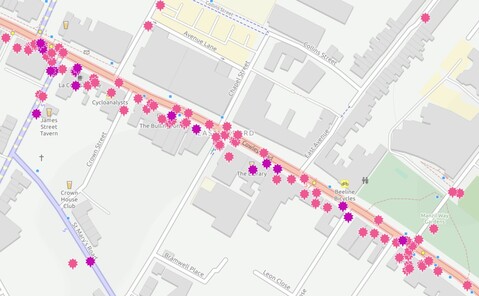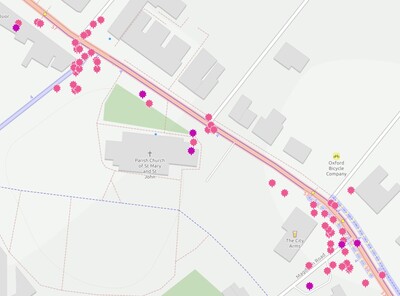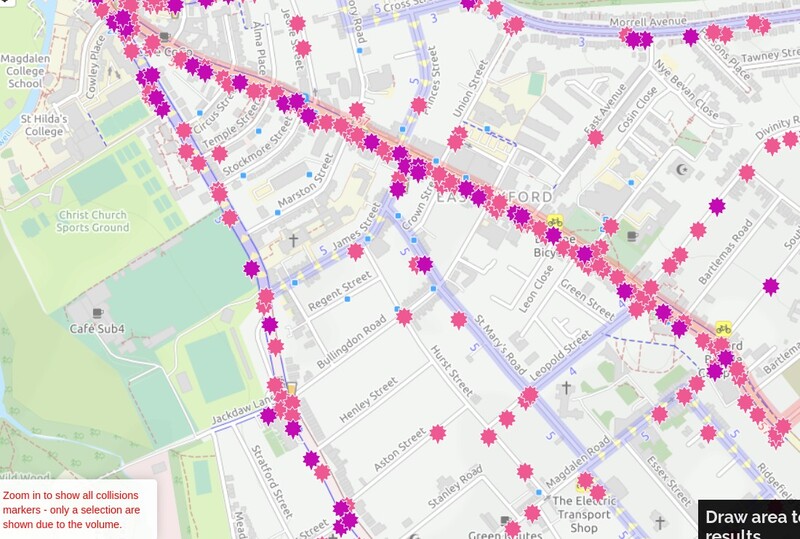This map shows the injuries from road collisions on the north-western end of Cowley Rd (the B480) between 2005 and 2019. The purple stars are serious injuries (resulting in overnight hospital stays) and the pink ones are slight ones (that resulted in police reports).
This map includes walking casualties as well, but the vast majority (maybe 80%) are cycling casualties. The map is taken from the Bikedata Collisions tool, which displays STATS19 data. (There were no fatalities on this stretch of Cowley Rd in this period, but there were two further out but inside the ring road and one in 2004 just before this dataset starts. Given the number of collisions happening, it's only a matter of time before the next one.)
One scary thing about this map is the red text in the bottom left: "Zoom in to show all collision markers - only a selection are shown due to the volume". If we do that, we can see even more injuries (click on the maps for larger versions).

part of the main retail strip
|

the junctions with Divinity/Leopold and Southfield/Magdalen
|
On top of this there will have been a large number of minor injuries and collisions — anything not reported to the police — and an even larger number of near-misses, some of which may have caused significant distress (assault rather than battery). And there's the invisible problem of people not being injured on Cowley Rd because it's so hostile they won't cycle there at all. That includes many fit but less confident adults, not just children, parents with children, and frailer and slower adults, and is a significant public health harm.
It's fairly obvious what the problems are. They are the standard hazards of cycling and Cowley Rd is only unusual in offering so many of them, at high intensity and in combination: a near-complete absence of any cycling infrastructure, high volumes of motor traffic, uncontrolled junctions with multiple movements, vehicles parking and leaving parking places, door zones, large numbers of buses blocking visibility and inducing overtaking, and a lot of pedestrians. Cycle freight firm Pedal & Post uses Cowley Rd as hazard perception training for its professional cycle couriers!
Cowley Rd is a key transport node. People need to walk or cycle across it and along it (there are only limited alternatives), and it is a major destination in its own right. Cowley Rd slices right through the catchments of two primary schools (East Oxford and SS Mary and John) and is unavoidable in trips to multiple secondary schools.
Local authorities have a duty to take steps to reduce and prevent accidents and a duty to promote road safety (the Road Traffic Act and other legislation). Local authorities also have a duty to to promote sustainable modes of school travel by children (Education Act 508A).
So what could be done about this? The following options address different aspects of the problem, and probably all of them are needed:
- The East Oxford LTNs would remove 80% or so of the traffic entering from or exiting to side streets, at the junctions with James, Rectory, Leopold, Divinity, Southfield, Magdalen, etc, where the greatest concentrations of collisions are. Ideally this would be complemented by fully continuous/blended pavements across those side-road entries. [Note: the East Oxford LTNs were implemented experimentally in 2022 and made permanent in October 2023.]
- A bus gate or traffic filter (either on Cowley Rd itself, or on St Clements and Longwall) would remove or reduce through private motor traffic. As well as potentially reducing road danger, this would also speed up the buses.
- Short-stay parking could be restricted to loading and delivery access, at specific hours, and to disabled users, ideally in side-street stubs. This would remove the danger from cars pulling in and out of parking, and from dooring, and would allow cycle lanes on some of the route. [Note: this is envisaged in Action 6 of the Central Oxfordshire Travel Plan: "Remove on-street public parking where necessary on corridors identified in the strategy as either being active travel Primary Routes (Quickways) or situated on core bus routes."]
There are a number of things that would help, but only a little bit.
- Speed limits are already 20mph for most of this stretch of Cowley Rd, and because it is so busy they are not exceeded too much. Better enforcement wouldn't hurt, however, and extending the 20mph area at least as far as Bartlemas Close seems obvious. But this is not going to make much difference by itself. [Note: the speed limits on Cowley Rd were reduced to 20mph in spring 2022, as part of the Quickways schemes]
- Signalled junctions would help, but they are expensive and would only improve things where they are installed. If this is all that can be done, then Divinity-Leopold and Southfield-Magdalen would seem the highest priority candidates.
- Strict enforcement of parking regulations would avoid illegally parked vehicles blocking movement and visibility, and reduce parking movements, with fewer drivers trying every side-street in the hope of finding a place. But this is labour-intensive and thus expensive, and the gains from it would be minor.
Things that won't work:
- Any kind of "Shared space" ("mixed priority") approach without a drastic reduction in motor traffic. The current situation illustrates that mixing cycling with high volumes of motor traffic is unsafe. A shared space scheme (without provision of separate space for cycling) might work with much lower traffic volumes, but given there are upwards of 60 buses an hour using Cowley Rd in peak, achieving that would require all the traffic reduction measures above.
What other options are there? Doing nothing is not an option. Quite apart from its duties of care in regard to road safety, if the county is at all serious about its active travel goals then it has to make cycling on Cowley Rd safe and accessible. And making cycling a genuine alternative to driving short trips is essential for enabling modal shift and decarbonising Oxford's transport.
Note: this is also a Twitter thread.


Cowley road is supremely dangerous for cyclists. I would not have let my children cycle there. There are pinch points pushing cyclists into the road, not to mention parked vehicles. It was specifically designed to be like that. The reply from the County is that no-one has died since the changes were made.
Essentially it uses cyclists as a traffic calming measure, and since it is so dangerous to use, of course no-one will die if conceptually no-one uses it.
I filmed this on the way back from a leisure ride: https://youtu.be/JxpgNa2-oZ0
The other reply is that there is an alternative quiet route. I have to day that I don't know what that is, (do many people?), and I expect that it is not very direct.
Let’s do the first three items you listed. Unfortunately we will have to elect a council that actually wants this stuff. Ruffling feathers just isn’t in the current group’s dna I suspect.
Most of the comments and complaints seem much like those of non-locals who are shocked how busy it is compared to their own leafy wide boulevards, looking down on plebs getting in the way. I know some think cyclists are kings who should have all bow before them, but actually put yourself at least 4th, after pedestrians, public transport users and disabled motorists. Cowley Road goes through the highest density population in Oxford, thus lots of pedestrians walking to the shops etc, and it's on the way to Cowley etc. - most of the "town" (not gown) population, thus lots of busses and people going in all directions who do all sorts of things.
The cyclists in that film were overtaking on the inside - should they expect special space for that? Your dreams of making that easier makes the traffic faster when density is low. It used to be almost terrifyingly fast - kept me awake in the summer when I had windows open 100m away! The recent resurfacing etc. has made it pretty much as good as when it was first narrowed.
The great thing, especially for slower cyclists, about being narrow is that motorists accept that they can't squeeze past and actually wait - make it another metre wider and they will push past. The disadvantage for the aggressive cyclist is you often have to wait (as Jake and his mate in that video) - accept it - if you don't like it, go another way or pick another mode (as Jake should have done it they wanted to go on a fast cycle ride).
Stop trying to turn a city built in the horse drawn (pre cyclist) era into something it never can be. I know there's lots of cyclists in Oxford but there's far more non-cyclists who don't have multiple travel choices.
Responding to the previous comment. Amost all the people complaining about how dangerous cycling is on Cowley Rd - see the twitter thread for examples - are locals. Why else would they be cycling on Cowley Rd? It will be a large fraction of the people driving on Cowley Rd who are coming from "leafy boulevards" (?) outside Oxford.
The transport hierarchy (at least the one the county claims to follow, and which is supposedly standard for transport planning) is walking, cycling, public transport, service traffic, and private cars at the end, so people cycling some second behind pedestrians. And many people walking and cycling are disabled, so disability is orthogonal to modal concerns.
In any event, the concern of this post is safety. Are you seriously arguing that convenience for people driving is more important than people cycling being injured and maimed? Or that nothing should be done to try and reduce these injury rates?